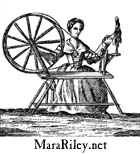 |
|
|
The reenactor faces a number of problems in creating a German colonist's impression. For instance, how much did German immigrants assimilate into their surroundings? How much of their distinctive culture did they maintain, and for how long? If you're creating a German impression, do you really mean German, or Swiss? If German, what area of Germany is your persona emigrating from? Few reenactors can speak the Pennsylvania Dutch dialect, so we choose to concentrate on clothing and material culture when creating our impressions. Since most of 18th century Europe was heavily influenced by French fashion, what was distinctive about German clothing in Germany? How much of that did they bring to the colonies? There's also a cultural double standard among reenactors. Reenactors look at European (French and European) artwork to see what the American colonists were wearing here, because there are very few pictoral records for what lower- and middle-class English settlers were wearing in the colonies, but somehow when one looks at German art to see what German-American colonists were wearing, that isn't considered to be valid documentation. Moreover, the assumption that everyone came here to assimilate as soon as possible ignores the actual history of Germans in the colonies. Yes, some of them settled among and married into English families very quickly, but in some areas of the country (Pennsylvania, North Carolina, some parts of Ohio) German language and culture hung on well into the 20th century, bolstered by fresh waves of immigrants. In fact, German is still the fifth language most commonly spoken at home in North America today. In the interest of full disclosure, my own family comes from a variety of backgrounds -- English, French Huguenot, German, Dutch, Scottish, and Welsh. The German branch intermarried and assimilated very quickly, so I'm at a disadvantage in creating this impression. Still, I think we're all handicapped by being 200+ years from the founding generation. So, without further ado, here are my notes on Pennsylvania German clothing in the 18th century.
|
|
|
|
Women's Clothing: Tracht, or regional German costume, had not yet solidified in the 18th century. Clothing definitely had regional distinctions, and you can start to see the beginnings of tracht, but we don't have enough information to really get into what those distinctions were. The higher-class the woman, the more her clothes were influenced by French fashion. However, middle-upper class women do show some regionalisms when wearing their best clothing to sit for portraits.
|
|
|
|
